GammaTech DURABOOK SA14
Attractively priced semi-rugged 14-inch notebook with high-performance Intel "Kaby Lake" 7th generation Core processors, good connectivity, and numerous customization options
(by Conrad H. Blickenstorfer; photography by Carol Cotton)
There are laptop computers designed for customers who need more durability and ruggedness than standard consumer notebooks generally provide. GammaTech has been in this market for many years (see GammaTech celebrates its 30th anniversary], and their semi-rugged DURABOOK SA14 is a prime example of such a machine, one that can easily be adapted to a wide range of applications and environments but costs only about half as much as a fully-rugged notebook. The comparatively low price certainly makes it attractive as does GammaTech's effort to keep the platform technologically up-to-date, most recently with making available advanced Intel 7th generation "Kaby Lake" Core processors.
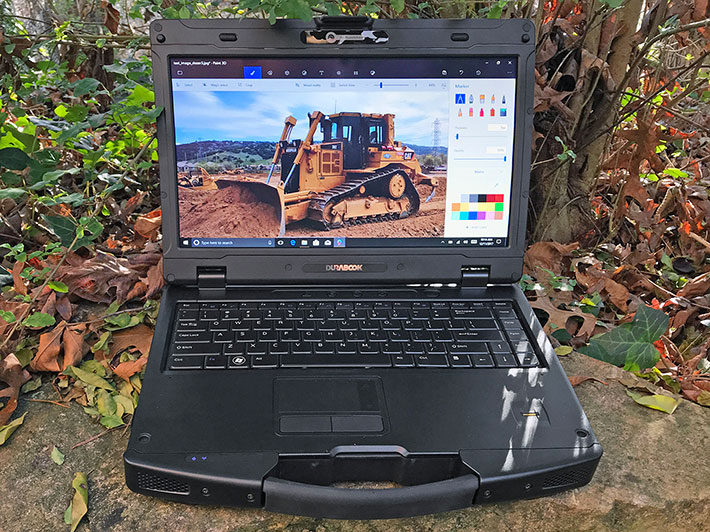
Where does this DURABOOK fit in and what can it do? At RuggedPCReview.com, we're often asked what laptop is best for challenging jobs. Almost always, the answer is "it depends." Unlike consumer notebooks which generally live sheltered lives in homes, offices, and perhaps a trip or two, rugged and semi-rugged computers may encounter a very wide variety of conditions. Those conditions can range from mild (like use in a field office) to demanding (such as use in a vehicle) to extreme. Consumer-grade hardware is inexpensive but may break. Extreme costs extra and generally means compromise in weight and features.
Deciding on the right notebook for tough jobs can be like choosing between an extreme offroad vehicle or a standard SUV. GammaTech USA knows that and has always offered a range of durable, semi-rugged, and fully-rugged laptop computers that won't break the bank. As of late 2017, these are the ultra-rugged DURABOOK R8300 (see our review), the durable DURABOOK S15AB (see our review), the 2-in-1 DURABOOK R11 (see our review), and the DURABOOK SA14 discussed here. The SA14 is heavier and feels tougher than the larger S15AB but that's because its intended markets are, as GammaTech points out, in "military, field service, transportation, public safety and utilities sectors."
The DURABOOK SA14 — overview
The GammaTech DURABOOK SA14 is a full-size notebook with a 14.0-inch wide-format screen. It measures 13.5 x 9.65 (not including the handle) x 1.85 inches and weighs about 7.5 pounds, making it thicker 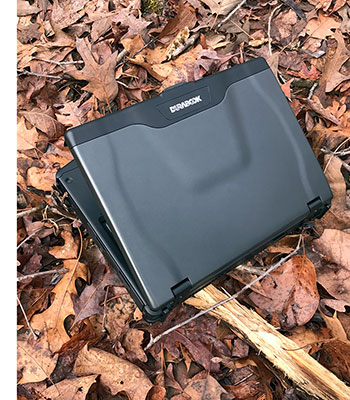 and quite a bit heavier than a standard consumer notebook. The design is no-nonsense purposeful without any needless bling and trim. The look nicely captures this DURABOOK's mission of providing significant mobile computing power in a package much tougher than any consumer laptop.
and quite a bit heavier than a standard consumer notebook. The design is no-nonsense purposeful without any needless bling and trim. The look nicely captures this DURABOOK's mission of providing significant mobile computing power in a package much tougher than any consumer laptop.
All the conveniences and features of a consumer notebook are there: a very legible full-size keyboard, up to a terabyte of either hard or solid state disk with a handy quick-release design, a DVD super multi drive, a wealth of card readers (PC Card, SD Card, Smart Card, SIM), enough memory (up to 32GB of state-of-the-art DDR4), and plenty of onboard connectivity both wired and wireless.
Much to GammaTech's credit, the company makes every effort to always offer late-model Intel processors. For this latest generation of the DURABOOK SA14, customers have their choice of 6th and 7th generation Core i5 and i7 CPUs. Our review unit came with the top-of-the-line (for the SA14) 2.8GHz Core i7-7600U dual-core vPro processor.
The DURABOOK SA14 has a hefty magnesium alloy chassis, very solid display hinges, protective corner bumpers, and it feels far more solid than any consumer laptop. All ports and card slots are behind protective doors. Note, however, that this is not a fully sealed machine. Its IP53 ingress protection rating means it can handle spills and some rain, but there are ventilation slots at the bottom. That's what semi-rugged means, a good deal of protection for most use scenarios, but not the total immunity to the elements provided by (much more expensive) fully-rugged systems.
Design, look, and feel — subdued elegance
The image below shows the GammaTech DURABOOK SA14 from the top and all four sides. The heavy magnesium alloy chassis means the computer doesn't flex and twist like standard plastic consumer laptops. The body of the SA14 is a very dark matte gray, the top of the LCD case is a dark matte silver-gray with a designated logo area (GammaTech machines often sell in rebadged versions). The top of the LCD case is contoured to add extra stiffness.
The DURABOOK SA14 nicely projects the tough tool-for-the-job look popular among most semi- and fully rugged notebooks. The heavy-duty LCD hinges offer good resistance when opening and closing the computer. When you close the lid, two small metal knobs fit into receptacles on the main body, securing the LCD case in place when in closed position. To open the notebook again, you push a spring-loaded lock.
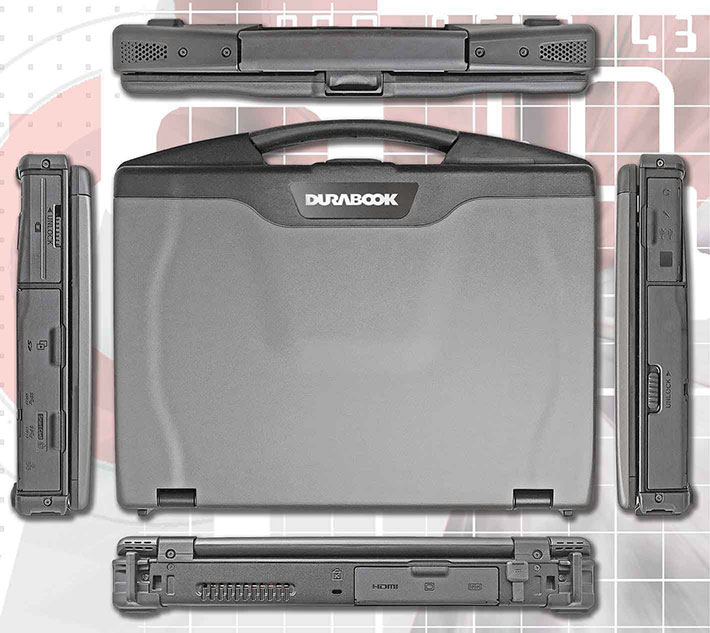
Ports and connectivity are located on the left and right sides, and the back of the computer. The ports on each side are located behind a single cover that protects against physical damage and also provides a good degree of protection against dust and liquids.
The two pictures below show a more detailed view of the left and right side of the DURABOOK SA14.
On the right side, from left to right, you can see the main battery compartment and then a large I/O block that includes a PC Card Type II slot, an SD Card reader, a USB 3.0 and a USB 3.0/eSATA combo port, an RJ45 LAN jack, and, above them, a Smart Card reader.

On the left side, from left to right, are the unit's super multi DVD reader/writer, two USB 2.0 ports, and the microphone and earphone jacks.

On the back of the machine, again from left to right, is the heat exchanger, then a Kensington lock slot, a standard HDMI port, a VGA port, and a legacy DB9 RS223 serial port.

Below you can see how the DURABOOK SA14 provides easy access to its interior via a large removable bottom plate. Embossed labels on the outside show what lies underneath: mSATA, WWAN, WLAN, DDR and CPU. The cover is held in place with eleven small Philips head screws, so passing rascals could not just pop open a cover and abscond with plug-in modules. Note that the cover has a good number of ventilation slots where water can easily get in. Remember, this is a spill-resistant laptop, but not a sealed one!
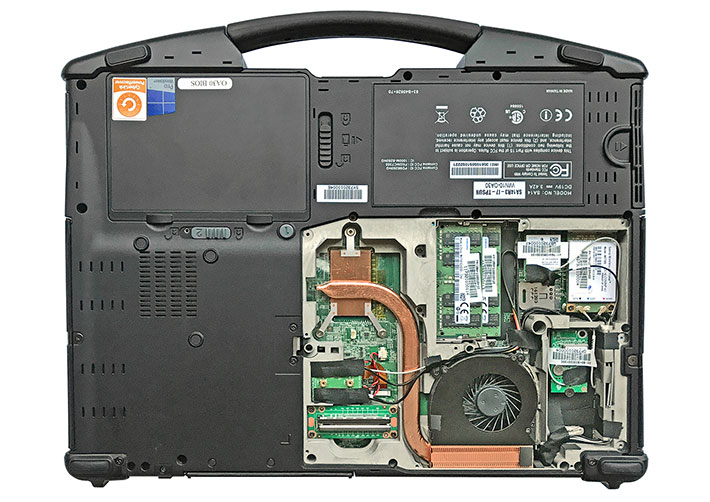
Once the cover is removed, you can see the copper heat tubing that removes heat from the processor to the heat exchanger/fan assembly. Good thermal management is crucial in notebooks designed to be used in a variety of operating temperatures, even with today's much more efficient and cooler-running processors.
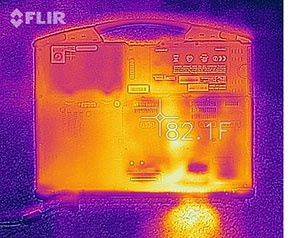 Since the SA14's thermal management systems were initially designed for much hotter-running standard voltage processors (i.e. 35 watt thermal design power instead of the current 15 watt), they have no problem at all in keeping things cool with the cooler-running chips in the updated machine. That means the fan in this new SA14 doesn't come on nearly as often, and the machine will be able to stay much longer at turbo clock speeds under heavy load and when it gets hot.
Since the SA14's thermal management systems were initially designed for much hotter-running standard voltage processors (i.e. 35 watt thermal design power instead of the current 15 watt), they have no problem at all in keeping things cool with the cooler-running chips in the updated machine. That means the fan in this new SA14 doesn't come on nearly as often, and the machine will be able to stay much longer at turbo clock speeds under heavy load and when it gets hot.
The picture on the left was taken with our FLIR infrared camera while the SA14 was running a benchmark. Note the "exhaust plume" at the right bottom where the fan expels hot air.
One could argue that switching to much more efficient processors that require less cooling would have been a good time to cut some size and weight off the SA14 platform, but redesigns are expensive and may obsolete existing docks and peripherals.
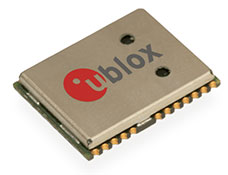 Above the fan are two SODIMM RAM slots. Our review machine came with dual 16GB Samsung sticks. The right lower corner has a compartment reserved for an optional expansion module. Our review unit came with a ublox NEO-M8N concurrent GNSS module.
Above the fan are two SODIMM RAM slots. Our review machine came with dual 16GB Samsung sticks. The right lower corner has a compartment reserved for an optional expansion module. Our review unit came with a ublox NEO-M8N concurrent GNSS module.
A great feature of the M8N is that it can track up to three of the four available GNSS systems concurrently, those being GPS (the US system), GLONASS (the Russian version of GPS), the European Galileo, and the Chinese BeiDou. The ability to track three of those systems means potentially triple the number of available satellites, making for quick starts, very good accuracy, and superior coverage.
Above the expansion area is a compartment that contains two PCIe slots. One is used for WiFi (an Intel Dual Band Wireless AC 8260 802.11a/b/g/n/ac with Bluetooth 4.2 in our unit), the other for optional WWAN (ours had a Sierra Wireless AirPrime MC7355). Both have prewired antenna leads. The compartment also contains a SIM card slot, and you can also see the externally accessible SD Card slot.
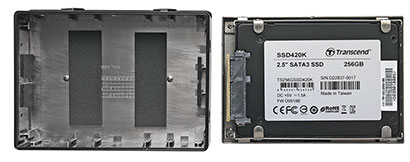 The hard drive is located inside a black plastic box that fits flush into the recessed compartment on the upper left. While the base SA14 comes with a 500GB or 1TB rotating hard disk, ours had an optional 2.5-inch 256GB Transcend solid state disk (see product page) with a SATA III 6Gb/s interface.
The hard drive is located inside a black plastic box that fits flush into the recessed compartment on the upper left. While the base SA14 comes with a 500GB or 1TB rotating hard disk, ours had an optional 2.5-inch 256GB Transcend solid state disk (see product page) with a SATA III 6Gb/s interface.
The assembly is designed to quickly be removed from the laptop (which is sometimes a requirement in some enterprise and government settings). The disk caddy is locked and unlocked via a friction lever. It is not likely to come lose unintentionally (in fact, it took a bit of force to pry it out).
We didn't dismantle the SA14 further, but just by removing the module compartment cover you can see the magnesium alloy chassis of the SA14. While many mobile devices have strong but rather flimsy looking metal chassis or subframes, the one in the SA14 is thick and sturdy and solid as a tank. This is one very tough machine inside.
Keyboard and touch pad — pleasant
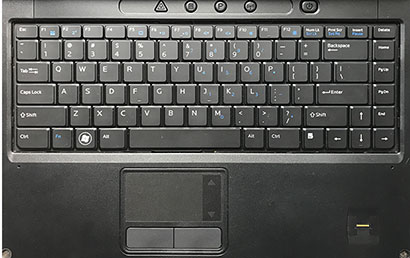 The DURABOOK SA14's keyboard is full-scale and has 86 keys. The key design is standard notebook (as opposed to the "chiclet" style keys often found in rugged machines) and the keys are black with white letters, numbers and symbols. Functions are indicated in blue.
The DURABOOK SA14's keyboard is full-scale and has 86 keys. The key design is standard notebook (as opposed to the "chiclet" style keys often found in rugged machines) and the keys are black with white letters, numbers and symbols. Functions are indicated in blue.
The keyboard has a blueish-white backlight that's activated via one of the function keys. It nicely outlines individual keys and lights up the white main and shifted key labels, but not the blue function labels.
Below the keyboard is the unit's touch pad. It is a properly sized and flush-mounted affair with a slight frame so your fingers feel the extent of the pad, and with two large and very responsive mouse buttons in front of it. along the right side is an integrated scroll area with a slightly different texture. The touch pad is very responsive and easy to use, but it can't be operated with gloves on (though it does pick up through some materials, like suede).
There are four buttons above the keyboard. The triangular one to the left is the stealth mode button that can be configured to instantly turn off the screen and all lights, or it can be set to night vision mode where the screen is just barely visible. Next to it is the desktop key, then a programmable function key, and finally a wireless on/off key.
Performance — excellent
The ideal rugged laptop is tough, powerful, handy, and has excellent battery life. In the past, this often meant a tenuous balance between speed, size, weight, battery life and thermal management. Things have gotten much better in the past few years. Batteries are lighter and more powerful, processors have become much faster and while drawing less power, and that goes for the rest of the electronics, too.
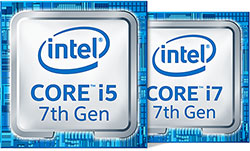 As is, the big news with the 3rd generation DURABOOK SA14 is that GammaTech raised performance, efficiency and security once again by switching to Intel's "Kaby Lake" processor platform.
As is, the big news with the 3rd generation DURABOOK SA14 is that GammaTech raised performance, efficiency and security once again by switching to Intel's "Kaby Lake" processor platform.
What is Kaby Lake all about and how is it better than the prior Skylake generation? It's not a drastic change. The architectures of both the cores and the graphics haven't really changed, but there are some additions that may be welcomed by many users. For example, Kaby Lake has much better 4K video capability now, mostly in the hardware encoding/decoding areas. And a new implementation of Speed Shift lets the CPU control turbo frequency instead of the operating system, which means the chip could speed up much faster. Process technology stays at 14nm, but Intel says that Kaby Lake transistors have taller and thinner "fins" that make for less "leakage" between transistors and allows slightly higher clock speeds, and that makes for performance gains between comparable processors.
|
DURABOOK SA14 R3: Processor options
|
|
PROCESSOR COMPARISON
|
Core i7
|
Core i7
|
Core i5
|
Core i7
|
Core i5
|
|
Model
|
7600U
|
7500U
|
7200U
|
6500U
|
6200U
|
|
Gen
|
7th
|
7th
|
7th
|
6th
|
6th
|
|
Cores/Threads
|
2/4
|
2/4
|
2/4
|
2/4
|
2/4
|
|
Base Clock Speed
|
2.80 GHz
|
2.70 GHz
|
2.50 GHz
|
2.50 GHz
|
2.30 GHz
|
|
Turbo Speed
|
3.90 GHz
|
3.50 GHz
|
3.10 GHz
|
3.10 GHz
|
2.80 GHz
|
|
Thermal Design Power (TDP)
|
15 watts
|
15 watts
|
15 watts
|
15 watts
|
15 watts
|
|
Smart Cache
|
4MB
|
4MB
|
3MB
|
4MB
|
3MB
|
|
Graphics base speed
|
300 MHz
|
300 MHz
|
300 MHz
|
300 MHz
|
300 MHz
|
|
Graphics max speed
|
1.15 GHz
|
1.05 GHz
|
1.00 GHz
|
1.05 GHz
|
1.00 GHz
|
|
Intel vPro
|
Yes
|
No
|
No
|
No
|
No
|
|
Intel TSX-NI
|
Yes
|
No
|
No
|
No
|
No
|
|
Intel SIPP
|
Yes
|
No
|
No
|
No
|
No
|
|
Intel Trusted Execution
|
Yes
|
No
|
No
|
No
|
No
|
Note that GammaTech didn't switch wholesale to Kaby Lake. Whereas the second generation SA14 was all Skylake, with four different Skylake chips available, this new third generation laptop offers a choice of three Kaby Lake chips as well as two of the prior Sky Lake processors.
The top processor option is now the Intel Core i7-7600U, with the also available Core i7-7500U just a bit slower, but without certain integrated Intel technologies that some customers may need. From the Kaby Lake Core i5 lineup GammaTech offers the mid-range Core i5-7200U.
Then there are the two Skylake processors that carry over, the Core i7-6500U and the Core i5-6200U. To view the full spec table for these five dual-core CPUs, see here.
Readers may wonder why GammaTech continues to offer the two Skylake chips from the prior generation. The answer is that Microsoft does only support Windows 10 on Kaby Lake, and no prior operating system. Given that as of late 2017, Windows 7 is still ahead of Windows 10 worldwide (per statcounter GlobalStats), a large number of users do not (yet) want to switch to Windows 10, and so GammaTech also ships the new SA14 with Skylake chips. Those models also come with Windows 10, but include a "downgrade option" to Windows 7.
What may make a difference in certain applications is the availability of four special Intel technologies (vPro, TSX-NI, SIPP, and Trusted Execution) included in the i7-7600U, but not in the other processors. Here's what that means:
- The extra security and manageability capabilities of vPro, especially, are required in many enterprise deployments.
- TSX-NI (Transactional Synchronization Extensions New Instructions) helps make parallel operations more efficient via improved control of locks in software,
- SIPP (Stable Image Platform Program) allows deployment of standardized, stable image PC platforms for at least 15 months, and
- Trusted Execution technology provides security capabilities such as measured launch and protected execution, and may thus also be an enterprise requirement.
To see what kind of performance the latest DURABOOK SA14 can bring to the party with its advanced "Kaby Lake" Intel Core processor, we attempted to run our standard benchmark suite, Passmark Software's PerformanceTest 6.1, that runs about 30 tests covering CPU, 2D graphics, 3D graphics, memory, and disk and then computes scores for each category and an overall PassMark score. Unfortunately, the very old version 6.1 of PerformanceTest that we use to maintain comparability among all of the many hundreds of machines we benchmarked here at RuggedPCReview would not run on the state-of-the-art Windows 10 and Kaby Lake-powered SA14. So we also ran our second benchmark suite, CrystalMark, to provide some clues as to overall performance levels.
For comparison and to provide an idea where the new SA14 stands, we included benchmark results of the fairly recent second gen SA14, the original SA14 we tested four years ago, GammaTech's own S15AB durable laptop, and the last couple of Getac laptops we've had here in the lab.
The results are as follows:
|
GammaTech DURABOOK SA14 R3 Benchmarks and Comparisons
|
|
PERFORMANCE COMPARISON
|
GammaTech
|
GammaTech
|
GammaTech
|
GammaTech
|
Getac
|
Getac
|
|
Type
|
Notebook
|
Notebook
|
Notebook
|
Notebook
|
Notebook
|
Notebook
|
|
Class
|
Semi-rugged
|
Semi-rugged
|
Semi-rugged
|
Durable
|
Semi-rugged
|
Fully-rugged
|
|
Model
|
SA14
|
SA14
|
SA14
|
S15AB
|
S410
|
B300
|
|
Year tested
|
2017
|
2017
|
2013
|
2016
|
2016
|
2017
|
|
Processor Type: Intel
|
Core i7
|
Core i5
|
Core i7
|
Core i5
|
Core i7
|
Core i7
|
|
Processor Model
|
7600U
|
6200U
|
3520M
|
5200U
|
6600U
|
6500U
|
|
CPU Speed
|
2.80 GHz
|
2.30 GHz
|
2.90 GHz
|
2.20 GHz
|
2.60 GHz
|
2.50 GHz
|
|
Turbo Speed
|
3.90 GHz
|
2.80 GHz
|
3.60 GHz
|
2.70 GHz
|
3.40 GHz
|
3.10 GHz
|
|
Thermal Design Power (TDP)
|
15 watts
|
15 watts
|
35 watts
|
15 watts
|
15 watts
|
15 watts
|
|
CrystalMark
|
|
|
|
|
|
|
|
ALU
|
55,408
|
43,828
|
55,163
|
41,280
|
51,255
|
48,741
|
|
FPU
|
55,119
|
43,500
|
52,406
|
37,524
|
54,658
|
51,552
|
|
MEM
|
70,836
|
43,185
|
46,309
|
44,983
|
38,245
|
58,244
|
|
HDD
|
38,827
|
37,626
|
6,853
|
40,383
|
10,170
|
33,772
|
|
GDI
|
20,393
|
13,538
|
18,200
|
17,033
|
17,500 est
|
17,007
|
|
D2D
|
6,989
|
5,478
|
2,568
|
6,735
|
6,500 est
|
6,194
|
|
OGL
|
16,474
|
12,303
|
7,090
|
8,184
|
16,000 est
|
15,246
|
|
Overall CrystalMark
|
264,046
|
199,458
|
188,589
|
196,122
|
194,328 est
|
230,756
|
Despite not having our usual PassMark test results, our secondary benchmark suite showed a number of things:
First, although this third generation DURABOOK SA14 uses processors that draw much less power than those available with the original SA14 of just four years ago (15 watt vs 35 watt), the new model blows away the original one in overall performance, and also decisively beats the Gen 2 SA14 we tested earlier in 2017.
Second, again and again we see that newer generation Intel processors may not necessarily be much faster and their clock speeds have hardly changed over the years. What has changed dramatically, though, is their efficiency. Performance levels that used to require power-hungry standard-voltage chips can now be done with much cooler-running low-voltage chips. Graphics performance, amazingly, hasn't changed nearly as much as one'd expect, given Intel's marketing messages.
Third, and we cannot emphasize that enough, the type of mass storage installed can make a huge difference in overall performance. In our benchmarks, solid state disks consistently outperform rotating media by large margins. SSD prices have come down a lot, but they are still higher than those of conventional hard disks, especially at higher capacities. So we now have this frustrating situation where SSDs are so much quicker and more desirable, but they usually come in low storage capacities to keep system prices acceptable, just when we need more and more storage space.
Power draw and battery life
What does all of this very significant performance mean for the SA14's battery life? Competing semi-rugged laptops such as the Getac S410 or the Panasonic Toughbook 54 have modestly sized primary batteries to keep weight low, and both offer optional secondary batteries. The SA14, on the other hand, comes with a beefy 87 watt-hour battery that weighs over a pound all by itself to begin with, and the optional smaller 31 watt-hour secondary battery is only available if an SA14 comes with mSATA mass storage and leaves the hard drive bay available for a second battery.
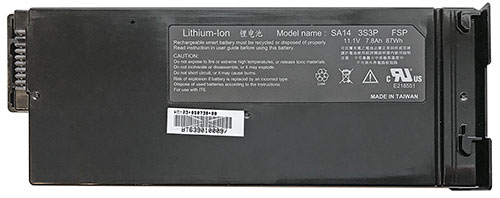 As is our standard procedure, we used Passmark Software's BatteryMon power management benchmark utility to measure the GammaTech laptop's power draw under various operating conditions.
As is our standard procedure, we used Passmark Software's BatteryMon power management benchmark utility to measure the GammaTech laptop's power draw under various operating conditions.
First we set the Windows 10 power options to "Balanced" and display brightness to its lowest setting (0%). That way we saw an idle power draw of 5.0 watts. We then cranked the backlight up to 50%, and draw increased to 7.2 watts. Then we cranked brightness all the way up to 100% and saw 8.8 watts.
Next we set the Windows 10 power options to "Power Saver" and display brightness at its lowest setting (0%). That way we saw an idle power draw of 4.9 watts. We then cranked the backlight up to 50% and draw increased to 7.2 watts. Then we cranked brightness all the way up to 100% and saw 8.9 watts.
|
Durabook SA14 R3 Power Draws (at idle)
|
|
Backlight level
|
Lowest (0%)
|
50%
|
Maximum (100%)
|
|
Power Saver
|
4.9 watts
|
7.2 watts
|
8.9 watts
|
|
Balanced
|
5.0 watts
|
7.2 watts
|
8.8 watts
|
|
Max Performance
|
5.4 watts
|
7.6 watts
|
9.2 watts
|
Finally, we set the tablet to "Max Performance." At the lowest brightness we saw an idle power draw of 5.4 watts. At 50% brightness draw increased to 7.6 watts. And at the maximum standard brightness setting, electric draw reached 9.2 watts.
What do those power draw figures mean in terms of projected battery life? The beefy Li-Ion battery of the SA14 has a capacity of 86.6 watt-hours. Dividing that by the 4.9 watt minimum observed draw would indicate 17.7 hours of theoretical battery life with the system staying awake the whole time. That's significantly more than GammaTech claims. In the maximum performance settings and maximum brightness, theoretical battery life would still be 9.4 hours.
We compared these power draw figured with those of the last SA14 we had in our lab. The current one has the most powerful processor and the daylight-viewable screen, the prior one had the low-end processor and the standard display. We found the new machine to draw less power, probably in part due to extra efficiency in the Kaby Lake chip and a screen backlight setting that went started with truly minimal backlight. However, with power settings and backlight to maximim, the new machine used about a watt more than the older one, likely due to the stronger screen backlight.
As always, real world mileage will vary. Minimum draw in a test lab is not an accurate predictor of actual battery life. However, it appears that the power management of the 7th generation "Kaby Lake" Intel Core chips works very well indeed. Combine that with Windows 10's good power management, and this 3rd gen SA14 is far more power-efficient than the original despite vastly increased performance. GammaTech's claim of 8.5 hours should easily be possible, and more via the optional second battery that goes into the hard drive bay (for units equipped with mSATA solid state drive). Do keep in mind, though, that power settings do affect clock speed.
Display — bright and great reflection control
The DURABOOK SA14's display measures 14.0 inches diagonally and it uses the still popular 1366 x 768 pixel format that translates into a wide-format 16:9 aspect ratio. That works well for running legacy professional software applications that were usually designed for the 1024 x 768 XGA display standard, and there's extra room on the side because the SA14 screen is 30% wider. 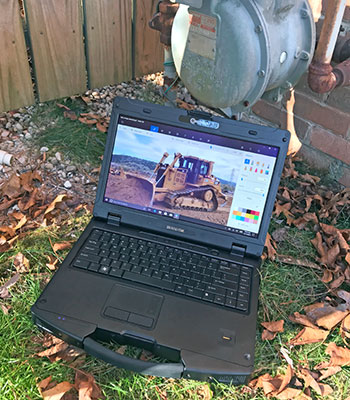 The wide format display gives the DURABOOK a contemporary look compared to some of the popular rugged notebook lines that still use the old 4:3 aspect ratio for backward compatibility reasons.
The wide format display gives the DURABOOK a contemporary look compared to some of the popular rugged notebook lines that still use the old 4:3 aspect ratio for backward compatibility reasons.
In terms of sharpness, the display offers 112 pixels per inch. That's not much by modern tablet and smartphone standards, but, in fact, about as much as non-retina Apple iMacs and MacBook Pros.
GammaTech literature describes the SA14's screen as "brilliant" and the official brochure lists the display as sunlight readable with anti-reflective coatings and an enhanced-brightness LED backlight. The specs state a 500 nits brightness rating for the sunlight-readable display installed in our review unit. Optical coatings and enhanced brightness, of course, are the current recipe for outdoor/sunlight viewability.
As is, what we can report is that the DURABOOK's display is indeed nice and bright — brighter actually than the 500 nits rating suggests — and bright enough for almost all outdoor use. Its surface is semi-matte, eliminating most of the reflection and glare common to most of today's consumer notebooks, and there seems to be a degree of anti-glare applied to it.
The horizontal viewing angle is quite wide. There are no horizontal color shifts, but the picture gets milky when viewed from the left side. The vertical viewing angle isn't nearly as good, with significant color shifts as the viewing angle veers away from straight-on.
The pictures below shows the SA14 R3 outdoors in a shady spot on a bright and sunny early afternoon day in mid-December. The display backlight is up to full brightness. The screen looks bright, vibrant and very readable when viewed head-on. Viewing it at a vertical angle yields the above mentioned brightness and contrast degradation.
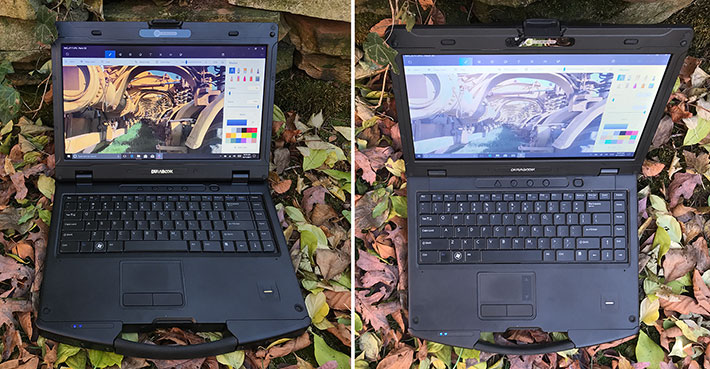
The pictures below show a comparison between the DURABOOK SA14 and an original Apple iPad Pro 12.9-inch (which is said to have about 430 nits) in bright sunshine. Brightness was perceived as roughly the same, but the DURABOOK screen is unaffected by reflections whereas the iPad Pro display with its glossy screen showed strong reflections and sometimes became unreadable.
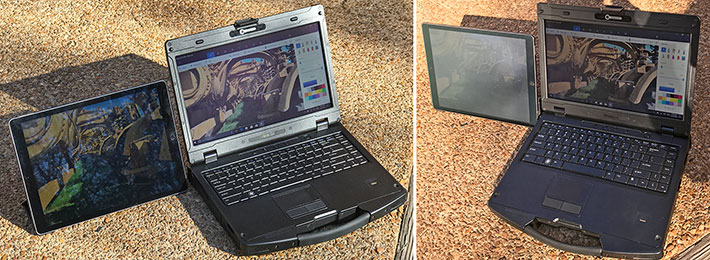
Overall, the DURABOOK SA14 gets the job done. It is very bright and contrasty indoors, bright and contrasty outdoors, and it remains quiet readable even in sunlight. Our preference would be for an IPS type of display with perfect viewing angles from all directions, and we hope GammaTech will make that available at some point. Likewise, while 1366 x 768 pixel resolution is adequate, those working with dense, complex applications may wish for higher resolution, and we wish GammaTech offered a 1920 x 1080 option.
Ruggedness — probably exceeds specs
The name "DURABOOK" certainly invokes connotations such as "tough," "durable," "reliable," etc. Unfortunately, there are no standards on what exactly defines "rugged" or "semi-rugged" or even "durable" or "business-rugged" or whatever else the industry has come up with. Even the often cited MIL-STD-810G really only describes the procedures for a variety of environmental tests. What it means is that the terms are quite elastic. GammaTech refers to the DURABOOK SA14 as "durable" and "semi-rugged" while the decidedly less rugged DURABOOK S15C is described as "rugged." Such inconsistency can be confusing to potential customers.
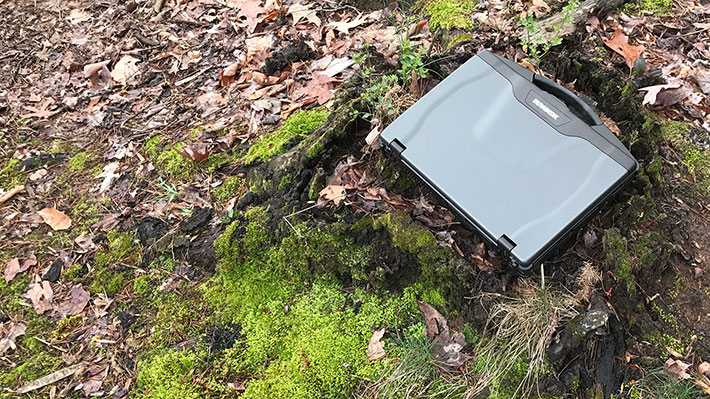
As is, GammaTech really only claims resistance to drops, shock, and spills, and describes the design limits in some detail.
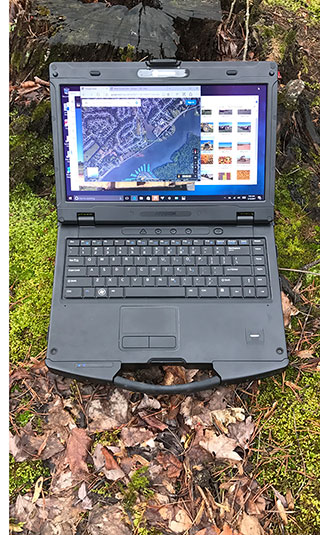 For drops, testing is conducted in modified accordance with the procedures described in MIL-STD-810G, Method 516.6, Procedure IV. Drops are from a height of 36 inches onto 2-inch plywood over concrete. The machine is then dropped four to six times with the display closed and unit turned off. After each drop, the machine must be able to boot. That is only marginally impressive impressive compared to the four (and higher) foot drops onto concrete some of the ruggeds can do, but it's in line with some of the other semi-ruggeds on the market.
For drops, testing is conducted in modified accordance with the procedures described in MIL-STD-810G, Method 516.6, Procedure IV. Drops are from a height of 36 inches onto 2-inch plywood over concrete. The machine is then dropped four to six times with the display closed and unit turned off. After each drop, the machine must be able to boot. That is only marginally impressive impressive compared to the four (and higher) foot drops onto concrete some of the ruggeds can do, but it's in line with some of the other semi-ruggeds on the market.
GammaTech also states shock and vibration resistance in testing similar to MIL-STD-810G, Method 514.6, Procedure I, Category 4, Fig 514.6C-1 which simulates traveling in a truck on a highway for 1,000 miles, compressed into 60 minutes. In addition, also adherence to integrity exposure as shown in Fig.6E-1 in the same section, as well as ASTM4169, Truck Transport, 11.5.2 Random Test, Assurance Level II (ASTM stands for American Society for Testing and Materials. The D 4169 standard sets tests and requirements for strength, durability and protective capability of packaging. Level II stands for medium test intensities and is most commonly used).
On the sealing front, GammaTech claims alternately IP5X and IP53-level protection. The "5" means protection against dust, with limited ingress permitted, and the "3" means protection against water spray spray up to 60 degrees from vertical. GammaTech supplied a splash/spill test document that describes how a deciliter of water can be spilled onto the keyboard, with the machine running.
As for the operating temperature range, the prior version SA14 claimed an impressive -4°F to 140°F (-20°C to 60°C), which meant the laptop could be used virtually anywhere. The specs for the SA14 R3 no longer list an operating temperature range. Since housing and construction haven't changed, we assume the operating temperature range remains the same.
As we've found in prior tests of DURABOOK computers, if you dig a bit deeper into GammaTech's materials and origin, past the official specs, you'll find that the machine offers quite a bit of vibration protection (as is evident from looking at its insides with all its shock absorption and magnesium construction) and that it's really tougher than the few supplied specs might lead one to believe. And Twinhead, GammaTech's corporate mothership in Taiwan, has decades' worth of experience making rugged computers — and not just semi-ruggeds, but also fully rugged and ultra-rugged ones. Twinhead is where the late General Dynamics Itronix notebooks came from, and also the tough and rugged GammaTech R8300.
So as far as we're concerned, the DURABOOK SA14 is definitely one tough machine, and a durable one. It's exceptionally sturdy and exceptionally well made. The machine deserves more detailed ruggedness specs, and perhaps they are available somewhere. Keep in mind, though, that weight is an issue: it's easy to make a handheld so it survives an 8-foot drop. With an 7.5-pound notebook, that's a different story.
Summary: The DURABOOK SA14 R3
The DURABOOK SA14 is a semi-rugged, super-solid notebook computer designed to be substantially tougher and more durable than standard consumer notebooks, but without the high cost of a fully rugged model. It's a very trust-inspiring, albeit rather heavy, machine with a bright, reflection-free 14-inch wide-format display, good connectivity, very good battery life, and excellent performance.
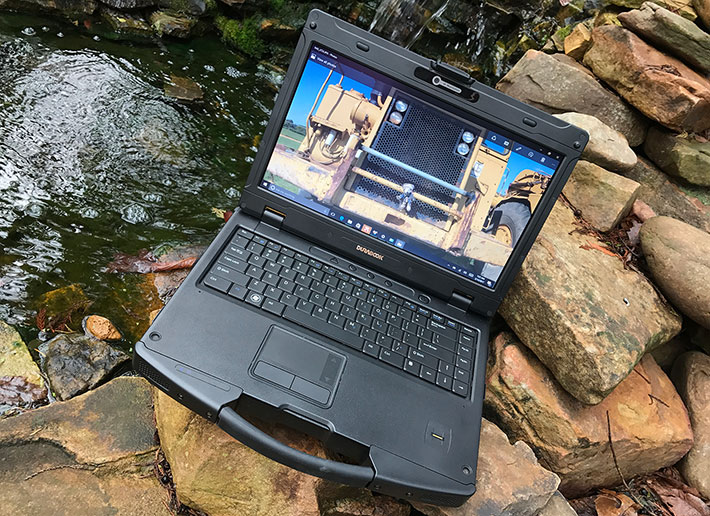
The starting price of the DURABOOK SA14 is amazingly low compared to fully and even most semi-rugged laptops, around US$1,700 or so for a bare-bones machine. DURABOOKs are built-to-order and available with in the usual wide range of configurations that can quickly drive up the price.
The DURABOOK SA14 has always been a good performer, and with the availability of 7th generation Intel Core processors, it's more powerful yet. The 2.80GHz Intel Core i7-7600U processor in our test unit is the high end of the five processors available for the SA14 (6th generation processor options available for those who want to run Windows 7). The laptop felt very quick and scored excellent overall benchmark results. Between the powerful 86.6 watt-hour standard battery and the very good power conservation of Intel's 7th generation processor technology, battery life is more than sufficient.
The DURABOOK SA14 has a bright 1366 x 768 pixel wide-format display that remains usable outdoors with virtually no reflection and glare. There is a resistive touch screen, but we'd have liked to see a higher resolution (like 1920 x 1080 pixel) display option.
While it's not immediately obvious from the modest ruggedness claims, the DURABOOK SA14 is an exceptionally solid and very well made machine. Its magnesium alloy chassis should hold up for a long time, and there is plenty of shock-mounting as well as plenty of internal protection. However, while the unit can handle spills onto its keyboard and such, it is not waterproof (open cooling vents to inside on side and bottom). Examine ruggedness specs to see if they match your requirements.
Overall, the DURABOOK SA14 with its wide-format display and powerful, efficient Intel 7th-gen Core processor options is a good deal for anyone who needs a high-performance, highly configurable notebook that is significantly tougher than standard consumer laptops and should hold up very well in daily use.
– Conrad H. Blickenstorfer, December 2017
|
GammaTech DURABOOK SA14 Specifications
|
| Status |
Added 4/2013, full review 07/2013, full review 6th gen 03/2017, full review 7th gen 12/2017
|
| Product type |
Semi-rugged notebook computer
|
| Processor |
Intel 7th Gen (Kaby Lake) Core i7-7600U with vPro
Intel 7th Gen (Kaby Lake) Core i7-7500U
Intel 7th Gen (Kaby Lake) Core i5-7200U
Intel 6th Gen (Skylake) Core i7-6500U
Intel 6th Gen (Skylake) Core i5-6200U
|
| CPU speed |
Core i7-7600U: 2.80GHz (max Turbo Boost speed 3.90Ghz)
Core i7-7500U: 2.70GHz (max Turbo Boost speed 3.50Ghz)
Core i5-7200U: 2.50GHz (max Turbo Boost speed 3.10Ghz)
Core i7-6500U: 2.50GHz (max Turbo Boost speed 3.10Ghz)
Core i5-6200U: 2.30GHz (max Turbo Boost speed 2.80Ghz)
|
| CPU Thermal Design Power |
All 15 watts
|
| OS |
Kaby Lake versions: Windows 10 Pro
Skylake versions: Windows 10 Pro with Windows 7 Pro downgrade |
| Graphics Controller/Chipset |
Kaby Lake processors: Intel HD Graphics 620 with max. 32GB video memory, or optional AMD MXM module with dedicated 2GB Graphics (either optical drive OR AMD MXM module)
Skylake processors: Intel HD Graphics 520 with max. 32GB video memory, or optional AMD MXM module with dedicated 2GB Graphics (either optical drive OR AMD MXM module)
|
| Memory |
8GB to 32GB in two 204-pin DDR4 SODIMM sockets |
| Display type |
Transmissive TFT with 8-step adjustable backlight; optional 500-nits sunlight-readable with Night Vision mode
|
| Display size and resolution |
14.0"/1366 x 768 pixel (112 ppi) WXGA with stealth mode, optional 500 nits sunlight-readable display
|
| Digitizer/Pens |
Resistive single touch
|
| Keyboard |
86-key, optional waterproof keyboard |
| Storage |
2.5-inch 500GB/1TB SATA hard disk or 128GB to 1TB SSD with exclusive HDD quick-release feature (test unit had 2-1/2-inch SATA3 256GB Transcend SSD420K) |
| Multimedia Pocket |
DVD-RW Super-Multi
|
| Slots |
1 x SDHC Card, 1 x Smart Card, 1 x ExpressCard 54 OR 1 x PC Card Type II
|
| Housing |
Magnesium alloy chassis |
| Temperature |
-4° to 140°F (-20° to +60°C) |
| Humidity |
5 to 95% non-condensing |
| Vibration |
MIL-STD-810G, Method 514.6, Procedure I + ASTM4169, Truck Transport, 11.5.2 Random test, Assurance Level II |
| Ingress protection |
IP53 |
| Explosive Atmosphere |
NA |
| EMI |
NA |
| Shock: Functional |
MIL-STD-810G, Method 514.6, Annex Cat. 4, Fig. 514.6C-1; ASTM 4169, Truck Transport, 11.5.2 Random test, Assurance Level 2 (Operating) |
| Shock: Transit Drop |
MIL-STD-810G, Method 516.6, Procedure IV (26 3-foot drops to plywood over concrete) |
| Certifications |
FCC, DOC+ FCC ID, CE |
| Size (inches) |
13.5 x 9.65 x 1.85 inches (342 x 245 x 47 mm) |
| Weight |
7.5 pounds (3.4kg) as tested |
| Power |
9-cell 11.1V, 7,800 mAH 86.6 watt-hour Li-Ion ("up to 14 hrs."); optional hot-swappable second 6-cell 5,200 mAH battery |
| Camera |
2.0 megapixel webcam |
| Security |
TPM 2.0, cable lock slot, biometric fingerprint scanner, available Intel vPro and Computrace
|
| Wireless |
Intel Dual Band Wireless AC8260 802.11a/b/g/n/ac with Bluetooth 4.2, optional u-blox M8NGPS, optional Gobi5000 4G LTE WWAN
|
| Interface |
1 x USB 3.0, 1 x USB 3.0/eSATA, 2 x USB 2.0, 2 x RJ45, 1 x DB9 RS232, 1 x VGA, 1 x HDMI, audio in/out, dock, optional fingerprint scanner
|
| Price |
Starting MSRP US$????? |
| Contact |
GammaTech
|
| Website |
DURABOOK SA14 page |
| Brochure |
 DURABOOK SA14 brochure DURABOOK SA14 brochure |
| Warranty |
3 years DURABOOK standard warranty |
| Contact |
Durabook Americas, 48329 Fremont Blvd., Fremont, CA 94538, 510-492-0828 |
|






